Oil Nears 7-Week Low, Is Now A Time To Buy?
- This topic has 0 replies, 1 voice, and was last updated 2 months ago by .
-
Topic
-
Oil prices experienced a significant downturn on Thursday, February 13, 2025, with West Texas Intermediate (WTI) crude futures dropping approximately 1% to $70.5 per barrel, approaching levels not seen in nearly two months.
This decline was primarily attributed to growing optimism surrounding potential peace negotiations between Russia and Ukraine, a development actively encouraged by US President Donald Trump.
The prospect of peace talks has sparked speculation that sanctions on Russian oil exports, which have been in place since the conflict began nearly three years ago, could be lifted.
This would potentially flood the market with additional supply, putting downward pressure on prices.
Trump’s confirmation of imminent negotiations and his suggestion of a possible meeting with Russian President Vladimir Putin in Saudi Arabia have further fuelled these expectations.
Adding to the bearish sentiment, the US Energy Information Administration (EIA) reported a substantial increase in US crude inventories, surpassing market predictions.
The 4.1 million barrel rise in stockpiles signals a potential weakening in demand within the world’s largest oil-consuming nation, contributing to the downward pressure on prices.
Market anxiety has been compounded by Trump’s recent threats to impose new reciprocal tariffs on US trade partners.
These potential trade barriers have raised concerns about global economic growth and, consequently, oil demand.
The uncertainty surrounding Trump’s trade policies has introduced an additional layer of complexity to an already volatile oil market.
However, it’s not all doom and gloom for oil prices.
The International Energy Agency (IEA) has revised its global oil surplus projections downward, citing robust demand in Asia and the impact of sanctions on OPEC+ nations.
This adjustment suggests that the market may be tighter than previously thought, which could provide some support for prices in the longer term.
Regarding whether now is a good time to buy oil, the current market conditions present a complex picture for investors.
On one hand, the potential easing of geopolitical tensions and the prospect of increased supply from Russia suggest that prices could fall further in the near term.
Additionally, the threat of new tariffs and their potential impact on global growth add to the bearish outlook.
On the other hand, the IEA’s revised projections and strong Asian demand could provide a floor for prices.
Furthermore, if peace talks were to falter or if new geopolitical tensions arise, oil prices could quickly rebound.
Given these conflicting factors, now may not be the ideal time for risk-averse investors to buy oil.
However, for those with a higher risk tolerance and a longer-term investment horizon, the current price levels could present an opportunity to enter the market at a relatively low point.
As always, potential investors should carefully consider their risk appetite, conduct thorough research, and possibly consult with financial advisors before making any investment decisions in the volatile oil market.

Source: Trading Economics